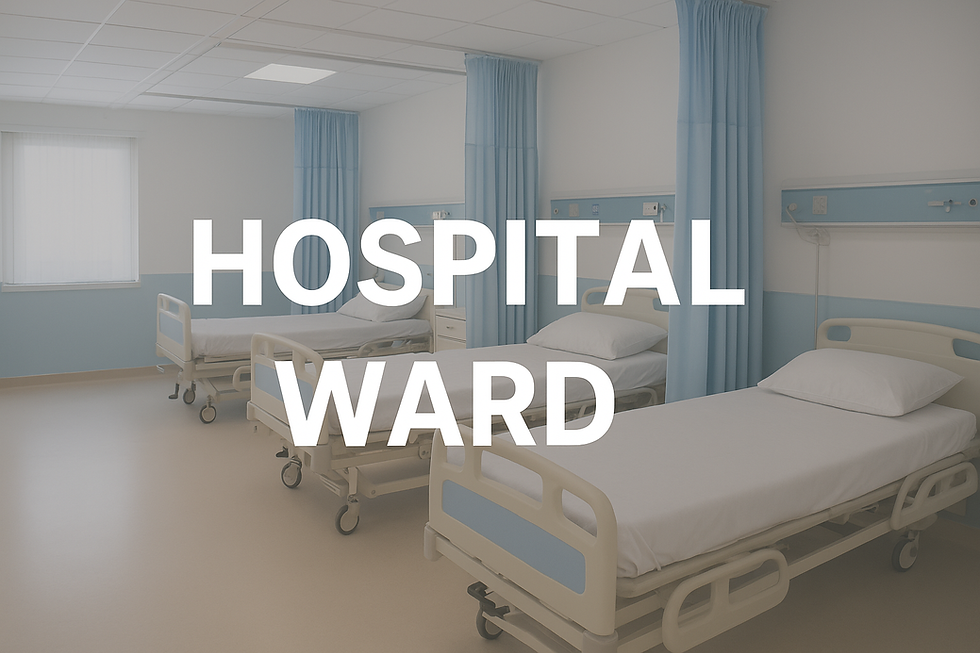Why anti microbial hospital beds are a game changer for infection control?
- Dhruv Dixit
- May 16
- 4 min read
It is no secret that hospitals, despite being places of healing, are also high-risk environments for infections. Every surface, every touchpoint, and every shared space in a healthcare setting has the potential to become a breeding ground for microbes. One of the most frequently used and often overlooked zones of contact? The hospital bed.

From patient turnover to emergency situations and long-term care, hospital beds are in constant use. That’s where antimicrobial hospital beds come in, a quiet innovation that’s rapidly becoming an industry standard. Not just for comfort or aesthetics, but as an active line of defense in the battle against healthcare-associated infections (HAIs).
Here’s why these beds are redefining the approach towards infection control:
1. The First Line of Defense Against Hospital-Acquired Infections (HAIs)
Hospital-acquired infections affect millions of patients globally every year, leading to prolonged stays, higher medical costs, and even increased mortality. Antimicrobial beds play a frontline role in preventing this.
Unlike standard beds, these are manufactured using materials or coatings that actively reduce microbial growth on their surfaces. We're not just talking about reducing stains or smells, these beds can inhibit bacteria like Staphylococcus aureus, E. coli, and MRSA, which are among the most common culprits in HAIs. Think of it as passive protection that never sleeps.
2. 24/7 Surface Protection Between Cleaning Cycles
Hospitals rely on routine disinfection protocols, but no amount of cleaning can keep a bed 100% germ-free at all times, especially in busy environments where cleaning can’t occur between every touch.
That’s where antimicrobial surfaces step in. They work continuously, providing around-the-clock protection, actively reducing bacterial presence in between cleanings. It’s not a replacement for hygiene, but it’s a valuable ally that reduces microbial load when human intervention isn’t possible.
3. Protects Vulnerable Populations
Pediatric, geriatric, and immunocompromised, certain patient groups are especially susceptible to infections. For these individuals, even minor exposure to pathogens can lead to serious complications.
Antimicrobial hospital beds offer an extra layer of safety for these groups. By minimising the possibility of pathogen transfer through touchpoints like siderails, headboards, and control panels, these beds help ensure vulnerable patients are cared for in a safer, more protected environment.
4. Reduces Cross-Contamination in High-Turnover Wards
Emergency rooms, ICUs, and surgical recovery units see rapid patient turnover. Despite best efforts, cross-contamination remains a very real risk when time is tight and surfaces are reused frequently.
Antimicrobial coatings on hospital beds help lower this risk substantially. With built-in microbial resistance, beds become less of a hotspot for pathogen transfer, even when there’s limited time between patients. It’s a game-changer for wards where every second counts, and every surface matters.
5. Durable, Long-Lasting Protection
The latest antimicrobial technologies are integrated during manufacturing, either as infused additives in the plastic or as specialized coatings on metal and polymer surfaces.
That means the protection isn’t skin-deep or temporary. It's baked into the bed’s material, remaining effective even after years of use, rigorous cleaning, and constant handling. And yes, they’re resistant to damage from common hospital-grade disinfectants too.
6. Improves Staff Safety Too
Healthcare workers touch bed surfaces constantly, when moving patients, changing sheets, adjusting positions, or conducting procedures. Every contact is a potential risk, not just for patients, but for the staff themselves.
Antimicrobial beds act as a buffer, reducing the likelihood of microbial transmission from patient to worker and vice versa. They don’t eliminate all risks, but they do significantly reduce one of the most common vectors: surface contact. Fewer infections mean fewer sick days, lower burnout, and a safer work environment for everyone on the floor.
7. Boosts Overall Hygiene Compliance
We all know how when nurses and cleaners see a visibly clean, well-maintained bed, the chances of complacency go up. But antimicrobial beds make hygiene proactive. They serve as a subtle yet powerful reminder that infection control isn’t just about occasional cleaning, it’s about continuous prevention.
These beds encourage better compliance and awareness across teams. When infection control becomes embedded into the very design of a room, it promotes a culture of cleanliness that extends beyond protocol.
8. Supports Accreditation and Infection Control Audits
Accrediting bodies and regulatory audits are paying closer attention to infection control infrastructure. Hospitals and care centers that show proactive measure, like antimicrobial furniture, score better on safety metrics.
Equipping rooms with such beds becomes part of the larger infection control narrative, aligning your facility with global standards like NABH, JCI, and WHO infection prevention guidelines. It’s not just about impressing auditors, it’s about demonstrating commitment to safer care.
Infection control in hospitals has traditionally been reactive: isolate, treat, disinfect. But the future is proactive, designing systems, environments, and equipment that stop infections before they begin. Antimicrobial hospital beds represent that future.
They don’t just improve hygiene, they transform how hospitals think about patient care. From ICU wings to pediatric wards, from rural clinics to multispecialty giants, every facility stands to benefit from adopting this technology. The question isn’t whether we can afford to use antimicrobial beds. It’s whether we can afford not to.
Why Choose Aslam Enterprises for Antimicrobial Hospital Beds?
At Aslam Enterprises, we believe patient care starts with thoughtful design. Our hospital beds are built with advanced antimicrobial technologies, ensuring round-the-clock protection and unmatched durability. But we don’t stop there.
Every bed is engineered for function, comfort, and hygiene, meeting the highest standards of infection control. From a specialty clinic, government hospital, to a private multispecialty unit, our solutions are tailored to support your needs while keeping safety at the forefront.
Backed by decades of industry expertise and a commitment to quality, Aslams continues to lead the way in redefining hospital infrastructure across India. Choose Aslams, and invest in beds that don’t just support recovery, they protect it.




Comments